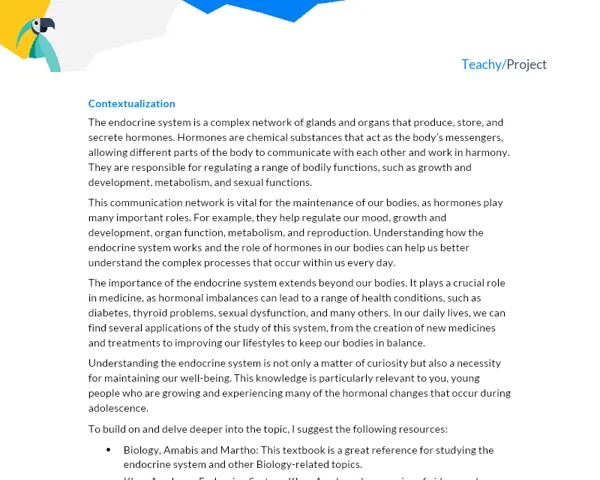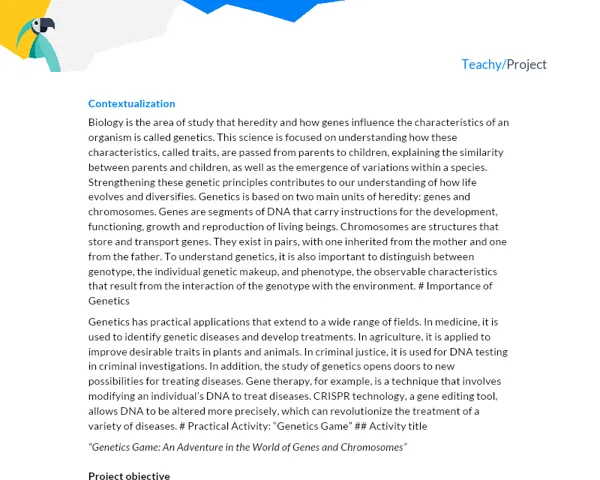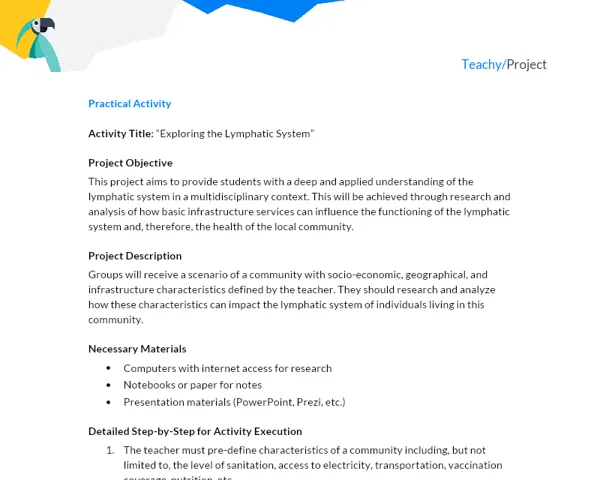Contextualization
Introduction
The Endocrine System is a set of glands responsible for producing hormones that are released into the bloodstream and regulate the body's functioning. It is essential to coordinate various functionalities of our body, such as metabolism, growth and development, organ function, reproduction, and general behavior.
Hormones are chemical substances produced in small quantities and have the function of regulating biological processes, acting as messengers that transmit information from one cell to another. They are released into the bloodstream and can act on cells near the production site (paracrine action) or on distant cells (endocrine action), depending on the type of hormone and the producing gland.
The main glands that make up the Endocrine System are the pituitary gland, the thyroid gland, the parathyroid glands, the adrenal glands, the pancreas, the ovaries in women, and the testicles in men. Each of these glands produces specific hormones that act on different physiological processes.
Importance and connections to the real world
Knowledge about the Endocrine System is of utmost importance, both for Biology and for Medicine and other Health areas. It is responsible for regulating practically all functions of our body, being the basis of various physiological processes that directly influence our health and well-being.
Furthermore, understanding how this system works is essential for the comprehension of various diseases and disorders, such as diabetes, hypothyroidism and hyperthyroidism, Addison's disease, among others. These are conditions that affect millions of people worldwide and require specific hormonal therapies for their control.
Activity
Activity Title: "The Hormonal Journey: A trip through the Endocrine System"
Project Objective
To creatively and playfully explore the Endocrine System, its glands and hormones, as well as their functions and impacts on the human body. By the end of this project, students should be able to understand the importance of the Endocrine System in human biology and its practical implications on health and diseases.
Detailed Project Description
Students, divided into groups of 3 to 5 members, will create a board game that simulates a journey through different glands of the Endocrine System. Each location on the board represents a different gland, where players will have to deal with challenges and questions about the function of such glands and the hormones they produce.
The main goal of the game is to be educational, promoting learning about the Endocrine System in a fun and interactive way.
Required Materials
- Cardboard or card paper for the base of the board.
- Colored pens, colored pencils, pencils, ruler, and other drawing and painting materials.
- Paper for creating question/challenge cards.
- Small pieces or objects that will be used as pawns in the game.
Step-by-step detailed activity execution
-
Research and Planning: Firstly, students should conduct the necessary research to understand the functioning of the Endocrine System, the glands, the hormones they produce, and their respective functions. The materials suggested in the introduction of this project can be a good starting point.
-
Board Drawing: Next, students should draw the board on cardboard or card paper. The board spaces should be divided among the different glands of the Endocrine System (pituitary gland, thyroid gland, parathyroid glands, adrenal glands, pancreas, ovaries, and testicles), with a space dedicated to the description of each one.
-
Rules and Challenges: Students should define the game rules, including how players will move around the board (for example, through a die or some other random mechanism). They should also create cards with questions or challenges about each gland and the hormones they produce, which will be answered by players when they pass through each space.
-
Card and Pawns Making: The question/challenge cards should be made on sturdy paper and the pawns can be made of any available material, such as bottle caps, paper clips, etc.
-
Report: After finishing the game, students should write a report following the instructions of this project.
Project Deliverables and its Connection to the Practical Activity
At the end of the project, each group must deliver:
- The board game made, including the board, the cards, and the pawns.
- A written report on the project.
The report should follow the following format:
- Introduction: The student must contextualize the theme, its relevance, and real-world application, as well as explain the objective of this project.
- Development: The student must explain the theory about the Endocrine System, describe in detail the game created, the methodology used for the project creation, and the results obtained, such as possible difficulties encountered and solutions adopted, as well as the learning obtained.
- Conclusion: The student must conclude the report by summarizing its main points, explaining the learnings obtained, and what they concluded about the work.
- Bibliography: Indicate the research sources used for the work.
The report and the developed game will provide a direct association of the learned theory with the experienced practice, consolidating learning about the Endocrine System and its functions.



